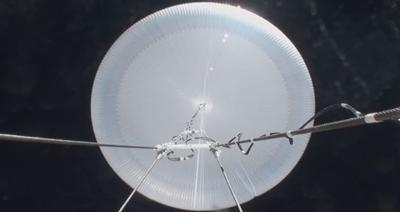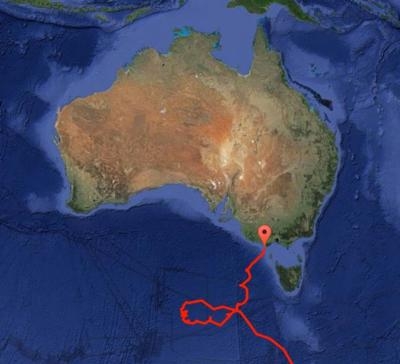Aircraft Landed April 27, Recovery Expected To Take Two Weeks
A NASA tracking and communications payload suspended beneath a super pressure balloon (SPB) landed safely upright via parachute in the Australian outback April 27 (April 28 in Australia) following the commanded flight termination of the balloon.

Now, NASA is tackling the difficult task of recovering the 3,500-pound payload (which includes the parachute and gondola) and 5,000-pound balloon, a process that could run up to a week given the challenges of operating in the remote area in southwest Queensland.
"The outback can be a tough, unforgiving, unapologetic environment to operate in," said Debbie Fairbrother, NASA's Balloon Program Office Chief who has accompanied past balloon recovery operations in the outback. "You need to be self-sufficient, you need a lot of logistics, and you need to plan for many different scenarios."
Following the flight's conclusion, NASA contracted with a local aviator to fly over the landing site, confirming the payload and balloon touched down near their predicted landing areas given wind and environmental conditions at the time. The balloon landing site is approximately 18.4 miles from the payload landing site.
Since then, NASA, working through a local citizen familiar with the area, has been in contact with the landowner in coordinating the recovery operation. Most of the six-person recovery team have arrived in country and are initially staging out of Adelaide, South Australia, where they have rented camper vans and supplies in order to operate in the remote area.
"If you run out of supplies, break or forget a piece of equipment, it's not like you can run to the local hardware store and be up and running again in 10 minutes," said Fairbrother. "The upfront planning will help ensure the safety of our team in the field and a successful recovery."
To lift and transport the combined 8,500-pounds of payload and balloon material, which is similar in appearance and thickness to sandwich bag material, NASA has rented a crane truck and a flatbed truck. Part of the team is arriving in Brisbane, Australia, May 7 to collect the trucks and drive them to Adelaide, at which time the entire team will proceed to the recovery location.

After the balloon and payload are recovered, the team will return to Adelaide, where they will containerize and ship both back to the United States for analysis. "We will investigate the cause of the leak and apply any lessons learned to future super pressure balloon flights," said Fairbrother.
The SPB test flight, which began March 26 EDT (March 27 in New Zealand) from Wanaka Airport, New Zealand, was the first time the SPB has flown for a long duration through the day and night cycle. Most standard heavy-lift zero pressure balloons can vary in altitudes as great as 45,000 feet during the alternating warming during the day and cooling at night. The SPB, which is designed to maintain a positive internal pressure and shape irrespective of its external environment, maintained a float altitude of 110,000 feet with minimal altitude variation for more than 30 days of flight through the day and night cycle.
NASA ended the flight after discovering and verifying a leak in the balloon.
"We hoped for more flight time, but are very pleased with the balloon's performance in what was by far the most rigorous test of the technology to date," said Fairbrother.
 ANN's Daily Aero-Term (04.30.24): Runway Centerline Lighting
ANN's Daily Aero-Term (04.30.24): Runway Centerline Lighting ANN's Daily Aero-Linx (04.30.24)
ANN's Daily Aero-Linx (04.30.24) Airborne 04.24.24: INTEGRAL E, Elixir USA, M700 RVSM
Airborne 04.24.24: INTEGRAL E, Elixir USA, M700 RVSM Airborne 04.29.24: EAA B-25 Rides, Textron 2024, G700 Deliveries
Airborne 04.29.24: EAA B-25 Rides, Textron 2024, G700 Deliveries Airborne-NextGen 04.23.24: UAVOS UVH 170, magni650 Engine, World eVTOL Directory
Airborne-NextGen 04.23.24: UAVOS UVH 170, magni650 Engine, World eVTOL Directory



